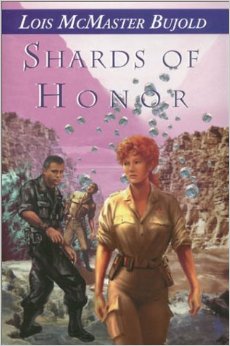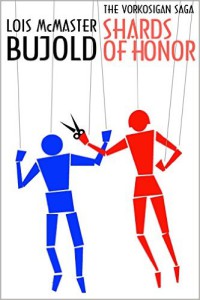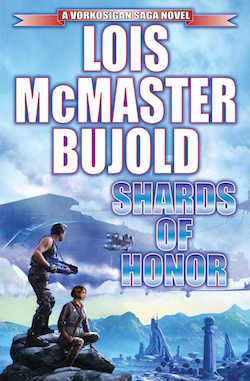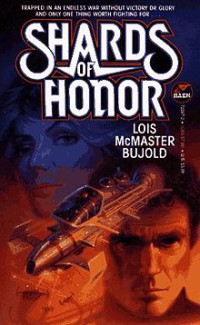This week we start re-reading Shards of Honor! We’re tackling the book covers and chapters 1-3.
Now that we have a whole book worth of blog posts, it seems worth mentioning that, like all re-reads, this one has an index. If you’re tuning in late and want to catch up on Falling Free, posts are linked here. The spoiler policy for this reread was fairly uncomplicated when we didn’t have any Vorkosigans to discuss at all. Now that they have arrived, please remember that both the blog posts and the discussion threads are open to spoilers for all books except Gentleman Jole and the Red Queen. Please white out any discussion of Gentlemen Jole until after Jole’s first appearance in The Vor Game.
Shards of Honor was the first Vorkosigan book published, hitting the shelves shortly before The Warrior’s Apprentice in 1986. Like all of Bujold’s books, it has been through a fair amount of cover art in the last 30 years.
The cover at the top of the post is the one on my copy of the book. Aral looks stalwart—fierce of jaw and cheekbone, like Gaston in Beauty and the Beast. Cordelia looks delicate and, mysteriously, blonde. Like Princess Diana. I feel that this cover emphasizes romance over interplanetary war. Aral and Cordelia are separated by a ship, which is sort of appropriate to the narrative, and also looks like nothing you would ever seriously consider sending into space. There is also a space battle going on in the lower left corner, but it’s not visually compelling. To me. Maybe to other people? This cover strongly suggests that the book is set in the future, and has characters in it, and there the information ends. It’s OK, as art goes. It serves its function for a book that had me at “Lois McMaster Bujold.”
 The cover on the right, from the NESFA press version, expands on the cast of characters by featuring Dubauer, shown here being stung by radials. Fun times. I feel like this is an excessive indignity for a character who is already forced to suffer more than anyone should. The artist hasn’t captured his bravery, his sacrifice, or the callous brutality with which Bothari shot him. He’s being completely ignored by Aral and Cordelia.
The cover on the right, from the NESFA press version, expands on the cast of characters by featuring Dubauer, shown here being stung by radials. Fun times. I feel like this is an excessive indignity for a character who is already forced to suffer more than anyone should. The artist hasn’t captured his bravery, his sacrifice, or the callous brutality with which Bothari shot him. He’s being completely ignored by Aral and Cordelia.
These covers come highly recommended as being “nearly identikit perfect” for the characters. Which may be true but is not necessarily a virtue—I look pretty bad in my driver’s license photo. Aral looks like he’s about to attack someone, and Cordelia has Lucille Ball’s hair. The style looks badly dated, and also highly improbable for this point in the 200 kilometer hike through the uncharted, unsurveyed wilderness. Aral’s uniform looks practical. Cordelia’s top half looks OK. Her lower half looks like the artist painted her nude and then added cargo pockets. I find these pants very upsetting.
 This next image suggests that Cordelia is cutting Aral free. I don’t feel that this fits with the plot. Perhaps the connection will become more clear in the course of the re-read.
This next image suggests that Cordelia is cutting Aral free. I don’t feel that this fits with the plot. Perhaps the connection will become more clear in the course of the re-read.
The mostly-blue version of the cover (below and to the right)—does well with the characters. Cordelia’s hair is the right color, and is practical for her life and circumstances. Since we’re looking at a shuttle taking off from the top of a mountain, I deduce that the man with her is Dubauer, and not Vorkosigan. It’s nice to see him in the moment when he’s responding to the emergency, not struggling as a victim of it. Despite appearances, the object he is holding would have to be his survey recorder and not a firearm.
 This cover focuses more on the far future of the series and the role that Sergyar will play in it than the immediate future of what will happen in the book. At least, this is the only explanation I have for the architecture in the background. I’m pretty sure Betan Survey camps don’t have that many skyscrapers. It can’t be the Barryaran supply Depot—that’s in a cave. It’s not the Barryaran prisoner processing camp either—the male character, who would be Vorkosigan if that were the context, would have to be in dress uniform and would not be armed. I would like this cover better if it was true to the locations described in the book.
This cover focuses more on the far future of the series and the role that Sergyar will play in it than the immediate future of what will happen in the book. At least, this is the only explanation I have for the architecture in the background. I’m pretty sure Betan Survey camps don’t have that many skyscrapers. It can’t be the Barryaran supply Depot—that’s in a cave. It’s not the Barryaran prisoner processing camp either—the male character, who would be Vorkosigan if that were the context, would have to be in dress uniform and would not be armed. I would like this cover better if it was true to the locations described in the book.
 Finally, the mostly reddish-orange cover on the right appears to be British or Canadian—at least, that’s what I infer from the bonus U in the title. This looks feasibly like a transport shuttle taking off from the supply cache. It emphasizes the space opera over the romance, which is not precisely true to the story. In fairness, the story DOES have shuttles, and a military base, and the two things intersect at several points in ways that are important to the plot. I don’t love this cover, but it’s the most accurate option that does not feature skintight pants.
Finally, the mostly reddish-orange cover on the right appears to be British or Canadian—at least, that’s what I infer from the bonus U in the title. This looks feasibly like a transport shuttle taking off from the supply cache. It emphasizes the space opera over the romance, which is not precisely true to the story. In fairness, the story DOES have shuttles, and a military base, and the two things intersect at several points in ways that are important to the plot. I don’t love this cover, but it’s the most accurate option that does not feature skintight pants.
SUMMARY
Cordelia Naismith, Betan Survey Commander, looks down from the mountain where she and her botanist, Ensign Dubauer are conducting a biological survey onto their campsite, and discovers that it is burning. When the team’s shuttle takes off and Naismith and Dubauer’s communicators fail to work, they head back down the mountain to discover that the camp has been ransacked, and her second-in-command, Lt. Reg Rosemont, is dead—Cordelia determines he was killed by a nerve disruptor. Cordelia locates a communication device and orders her crew to take their ship and run. She informs them that if captured, she and the ensign can be rescued through diplomatic channels, but only if someone gets back to Beta Colony to explain what happened. Her crew informs her that the attackers were Barryaran, and then one of the Barryarans shows up and shoots at Cordelia. Dubauer shields her with his body, knocking her into a ravine. Cordelia hits her head and loses consciousness.
She wakes up to find Captain Aral Vorkosigan pointing her stunner at her while she vomits in a mud puddle. Vorkosigan is disheveled and, except for Cordelia’s stunner, unarmed. He informs her that Dubauer is dead, and that they need to hike 200 kilometers (124.27 miles, for those of you who don’t feel like doing the conversion yourselves) to a supply cache that will allow him to “correct the problems in his command.” Complications ensue. Dubauer is not dead, but is clearly suffering from a serious neurological injury. He can walk, but he cannot understand speech or communicate, and is prone to seizures. They need to bury Rosemont. They have only the supplies on Aral’s belt and the things in Cordelia’s camp that aren’t too badly burnt—some cold lights, a pole, a shovel, a few bedrolls, and some instant rations—oatmeal and blue cheese dressing. The biological survey that Cordelia’s crew was carrying out on the planet is incomplete.
Still believing that her best chance to get home is through diplomatic channels, Cordelia offers Aral her parole if he will allow her to bring Dubauer along on the hike to the supply cache. Aral grudgingly agrees. And then they walk 200 kilometers.
COMMENTARY
Every time I read about Cordelia looking down from the mountain at the rain, I am thrilled again for everything that is yet to come. The planet where this all takes place will eventually become Sergyar. It has a pretty exciting future in front of it. Its biology is full of thrilling science fictional challenges, to fend off the case of girl cooties which the book might otherwise develop. In particular, I think it is worth noting that not only does Sergyar have vampire balloons float around sucking blood, they are also filled with hydrogen and explode dramatically when poked with a torch. The perfect cover for this novel would JUST be a painting of an exploding vampire balloon. The scene where Aral and Cordelia fend off a pack of hexapedal wolves by blowing up floaty vampires is really descriptive and dramatic. In five book covers, how has that not come up? I suppose it’s not easily rendered in abstract silhouettes of things, but the rest of the artists have not this excuse.
And actually, I take back the thing about abstract silhouettes. I could do it in stick figures.
Bujold started this piece as Star Trek fanfiction. The Barryarans were Klingon—some of Aral’s dialogue in this section of the book has a distinctly Klingon terseness. Beta Colony represents the Federation; The Betan Survey crew clearly meant to go where no man had gone before, but accidentally stumbled onto a place where the Barryarans have definitely been before. It’s like the neutral zone. Although she is commanding an exploratory mission, Cordelia is not an analog for Kirk. Neither she nor anyone on her crew is a military strategist. Their ship is designed to run away from a fight, not to win it. Aral’s commentary on the Betan Survey crew’s limitations as soldiers is scathing and somewhat insensitive, under the circumstances.
Sending these characters on a 200 km hike is a great way to introduce both of them and their cultures. Aral is a 40-something ship captain who used to be an admiral until he killed his political officer for ordering the execution of some prisoners during the military invasion of Komarr. The associated public relations disaster earned him the title “The Butcher of Komarr,” and he becomes very defensive when Cordelia remembers the news coverage. Cordelia is a 30-something Survey captain, in command of a scientific mission and a crew that likes to think creatively. They both lost a parent at an early age, Cordelia to a transport shuttle accident, Aral to an outbreak of Barryaran politics. Aral’s weapons of choice are plasma arcs and nerve disruptors; Cordelia prefers a stunner. As they get to know each other better, Cordelia confesses to having had a bad ex-boyfriend. Aral confesses to three murders.
I think it’s important to keep in mind that some of Aral’s dialogue is basically delirious babbling. In the course of their journey, he sustains a leg injury in an encounter with a large crab-like predator, burns his hands on a floating vampire balloon, and gets stung by some tiny radials whose hive he stood on to pee. He seems to function well most of the time, but he is suffering from infection and fever. These help explain why he sometimes has difficulty tracking conversational topics and discloses so much about his checkered past. Cordelia is recovering from a concussion but avoids further injury. Dubauer was already severely injured, and although he also gets stung by a floating vampire balloon, he makes solid progress towards recovery on this trip. I’m a history teacher, not a neurologist, but based on his ability to eat, sleep, indicate preferences, and undertake a 200 km hike (with assistance), I’m very optimistic about Dubauer’s prognosis. The seizures can probably be controlled with medication, and a good therapist should be able to help him communicate.
One of the notable things about Cordelia is the way she advocates for and provides support for people who need help. Her support keeps Dubauer alive. There is a lot more to come—Koudelka’s sword stick, Bothari’s job/Miles’s bodyguard, the recognition she instantly extends to Mark, Illyan’s datacube—a host of small gestures that give people what they need without infringing on their dignity. Aral remarks that she carries her civilization with her; She sees the dignity and humanity in others, even when they can’t necessarily see it in themselves. This ties to the idea of honor, which Aral sees as keeping his word. He’s fighting the appearance of having broken his word on Komarr, and is struggling to restore his honor as a result. He’s desperate for someone to see his dignity and humanity.
Aral will later admit that he has already fallen in love with Cordelia, while watching her vomit in the mud. By the end of this section, Aral’s delirium has made him very transparent. He asks Cordelia if Beta Colony has arranged marriages, and is appalled to discover that they don’t. Cordelia is slower to fall for Aral. This is hardly surprising; Assuming that Aral’s initial estimate of five days for the hike is correct, he confesses to an average of 0.6 murders per day, in addition to proposing that either he or Cordelia could slit Dubauer’s throat. And this is a book in which Aral is NOT the homicidal maniac.
We aren’t introduced to Bothari this week, but we do get to see him—he almost kills Dubauer—and learn a little about him. Bothari is going to have a long career with many moments of heroism despite, rather than because of, his challenges. Aral describes him as unpredictable, but this is clearly not yet Bothari’s lowest point.
Tune in next week, when Aral and Cordelia both deal with mutinies!
Ellen Cheeseman-Meyer teaches history and reads a lot.










